
Trinidad and Tobago
A Working Holiday in Trinidad
Linux and UNIX in Trinidad
I was visiting in Trinidad to teach a course on Linux/Unix security for TSTT, or Telecommunications Services of Trinidad & Tobago, the T&T telecom company. The job took me to Trinidad in mid-winter. That's a very nice time to visit the Caribbean!
The Last FourPhone Booths
in Manhattan
Just as in the U.S., public coin-operated telephony is well on the way out in Trinidad. When I was there, Trinidad was ahead of the U.S. in terms of the percentage of the people using mobile telephony exclusively or at least primarily.
Telephones connected by wires, how quaint.
But if you are from another country and you need to place a call, Trinidad has better public phones than many U.S. cities.

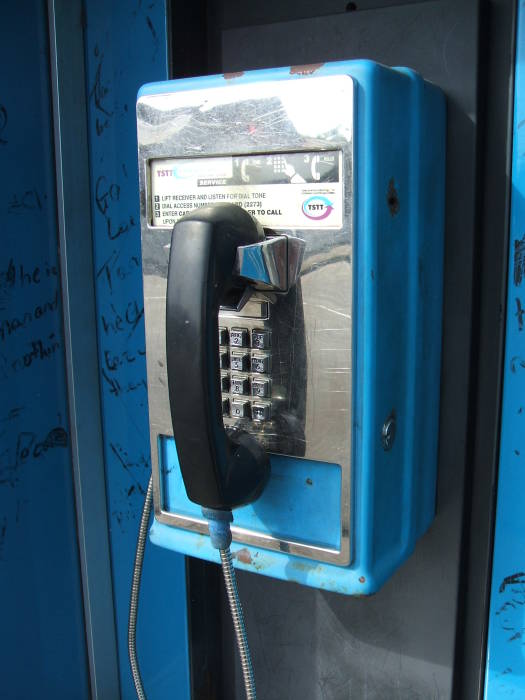
The Ride to Work
This is the start of a series of pictures showing my daily ride to work, photographed through a taxi windshield. Taxis are casual style in Trinidad, you sit up front with the driver.
I had to get to work by a certain time, fairly early in the morning, so I set up a deal with a local driver to pick me up at the hotel early in the morning and drive me out of Port of Spain to the west, to Chaguaramas. My return in the evening would be more casual.
Here we are heading out of Port of Spain toward the west.
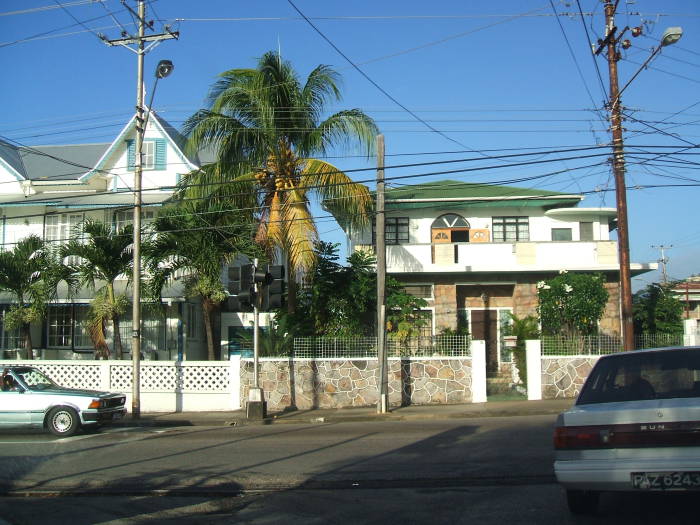

Traffic moves on the left side of the road in Trinidad, as you will see more clearly in the pictures below.
You see enormous satellite television antennas in Trinidad, like the one seen here. It's probably about 5 meters in diameter, and pointed down close to the western horizon as many were.
Trinidad is fairly close to the equator, so I expected satellite antennas to point almost straight up, as the geosynchronous orbit would be almost directly overhead. Some antennas did, but many were pointed very close to the horizon.
I wondered — were these for terrestrial troposcatter, to pick up Venezuelan stations well beyond the horizon?
No, they're for conventional geosynchronous satellite reception.
Trinidad is very far to the east compared to anything else in the Caribbean or North or South America. The satellites providing coverage for the Americas lie well to the west of Trinidad. Those satellites are fairly low in the western sky as seen from Trinidad, so the antennas are pointed accordingly. The antennas are large because Trinidad lies well outside the main downlink beam and so the signals are pretty weak.
Looking at a map, I would imagine that satellite antennas are pretty similarly sized and pointed all through the Caribbean islands from Trinidad all the way up through Puerto Rico.
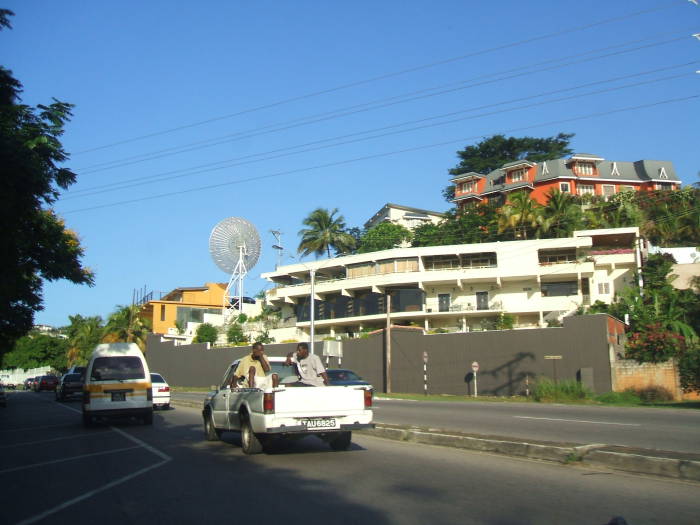
Amazon
ASIN: 3707907740

Amazon
ASIN: 1843538474
We have left Port of Spain, driven a little way along the coast, and now we are coming into the village of Carenage.
We're passing through Carenage. It's very quiet in the morning, but in the afternoon the local people would be walking along the road between the businesses.
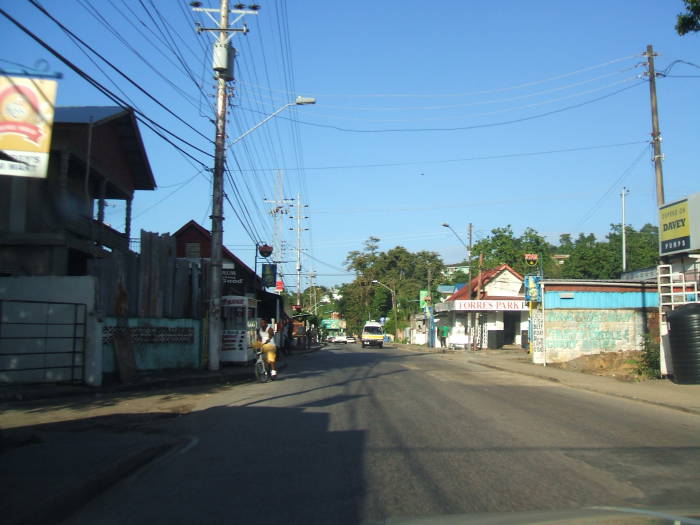

Carenage takes its name from its former livelihood of beaching sailing vessels for repair.
We're about to leave Carenage and pass along the Gulf of Paria.
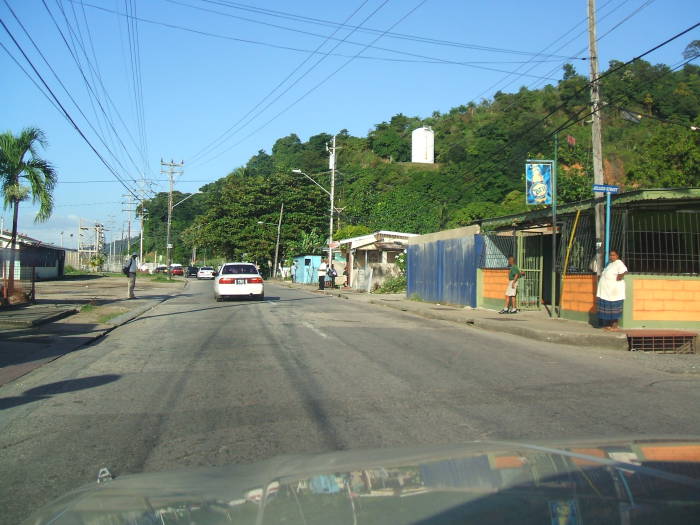
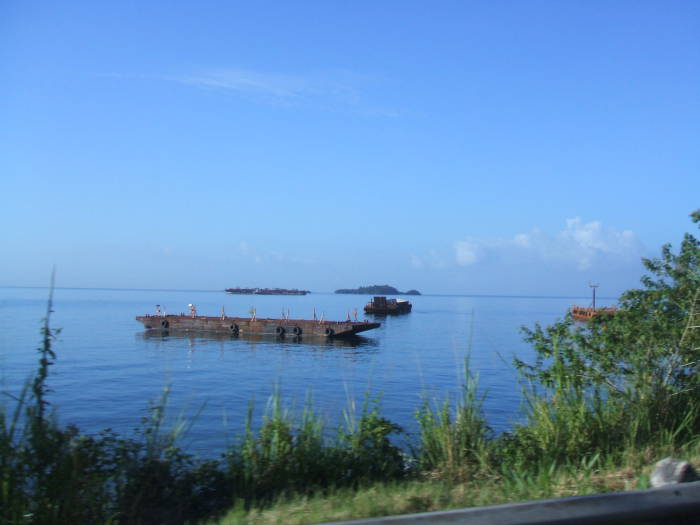
These barges are just past the big Alcoa bauxite loading facility to the west of Carenage. We're looking across the Gulf of Paria to some small outlying islands. Eastern Venezuela is out there over the horizon.
Bauxite is the main form of aluminum ore. It's a mixture of Al(OH)3 (gibbsite), γ-AlO(OH) (boehmite), and α-AlO(OH) (diasporite), alone with iron oxides, clay, and a small fraction of TiO2. The white aluminum compounds plus titanium dioxide, with an admixture of red iron oxide, coat everything around the bauxite ore facilities with a light pink powder.
Alcoa transports the bauxite to another facility for processing into aluminum. You heat bauxite ore in a sodium hydroxide solution in a pressure vessel at temperatures of 150-200 °C. You separate out the iron-based residues by filtration, yielding pure Al(OH)3 by precipitation on cooling. Heat that for conversion into aluminum oxide, Al2O3, which becomes molten at about 1000 °C. Then pass an electrical current through the molten Al2O3 to yield metallic aluminum through electrolysis.
For more about aluminum production tourist sights, see my page about Les Baux-de-Province in southern France.
Venezuela is famously wealthy with petroleum deposits, especially in its west around Lake Maricaibo. But petroleum related products, especially natural gas, are also found just off the coast of Trinidad, in the southern end of the Gulf of Paria.
Trinidad is the leading Caribbean producer of petroleum. Oil and gas make up about 40% of the gross domestic product and 80% of exports.
In 1857 the American Merrimac Oil Company drilled a well at La Brea in Trinidad. They struck oil at 85 meters, and that well came to be called the first successful oil well in the world. By 2005, Trinidad was producing 150,000 barrels or 24,000 cubic meters of oil per day. By 2007, natural gas production had reached an average of 4 billion standard cubic feet or 113 million cubic meters per day.
Trinidad and Tobago has earned a reputation as an excellent investment site for international businesses and has one of the highest growth rates and per capita incomes in Latin America. Economic growth between 2000 and 2007 averaged slightly over 8%, significantly above the regional average of about 3.7% for that same period; however, it has slowed down since then and contracted about 2.7% in 2009. Growth has been fueled by investments in liquefied natural gas (LNG), petrochemicals, and steel. Additional petrochemical, aluminum, and plastics projects are in various stages of planning. Trinidad and Tobago is the leading Caribbean producer of oil and gas, and its economy is heavily dependent upon these resources but it also supplies manufactured goods, notably food and beverages, as well as cement to the Caribbean region. Oil and gas account for about 40% of GDP and 80% of exports, but only 5% of employment. The country is also a regional financial center, and tourism is a growing sector, although it is not as important domestically as it is to many other Caribbean islands. The economy benefits from a growing trade surplus. The MANNING administration has benefited from fiscal surpluses fueled by the dynamic export sector; however, declines in oil and gas prices have reduced government revenues which will challenge his government's commitment to maintaining high levels of public investment.
— CIA World Factbook, April 2010
We're coming around the north end of the Gulf of Paria, and ahead we can see Chaguaramas Town and the ferry to Venezuela.
The West Indies Federation was a Caribbean federation of several British colonies. The goal was a political unit that would become a single state gaining independence from the United Kingdom. It would have consisted of about 24 main inhabited islands plus 220 to 230 minor islands, with a population of three to four million people.
The plan was to build this federation's capital at Chaguaramas. However, the West Indies Federation only lasted from January 1958 through May 1962. It failed because of the complete lack of local popular support, competing nationalism, weakness of the central government, political infighting, and many other problems.
On top of all of that, the planned capital was still a U.S. Naval Base.
Trinidad and Tobago gained full national independence within the British Commonwealth in August 1962, and it became a republic and elected its first President in 1976.
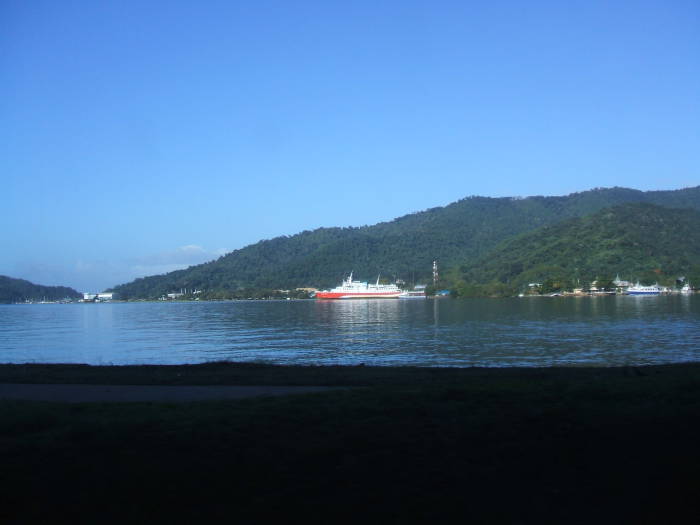
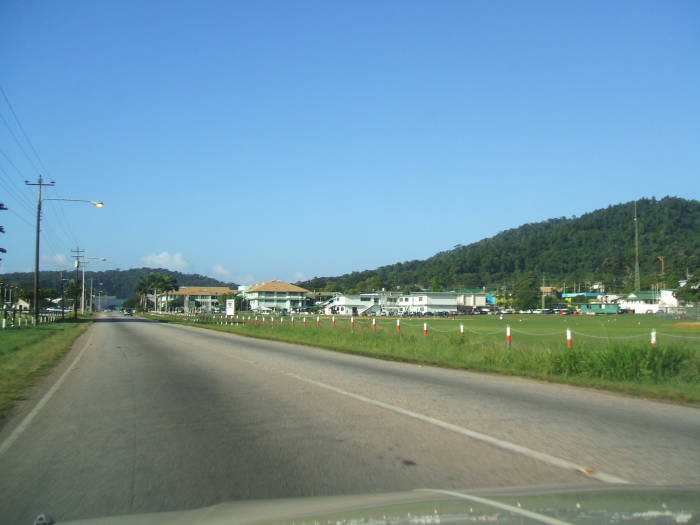
There's not a lot in Chaguaramas Town — some military facilities, the police academy and the fire academy, a large former resort facility the government operates as a conference center, the ferry terminal and an aviation museum. Plus the TSTT office where I was working.
The conference center hadn't been used for a year or two. Since we're in the tropics, the jungle and the moss and the fungus are taking over the buildings as if they have sat empty for decades. It's reminiscent of something from Graham Greene or Somerset Maugham.
Then again, maybe they have sat empty for decades....
The windows are left open at the TSTT center, the same as most places. Temperatures are in the 80s year-round, and there is little air conditioning.
At Work at TSTT
I'm at the work site, a TSTT facility at Chaguaramas.
The report I had before leaving the U.S. was that the gear and books were already at the course site. But when I got to the site the first morning, to set up the course the day before it started, I found that the shipment was still at the airport.
It wasn't until the middle of the afternoon that we learned that it was still in customs! Meanwhile, we had been told it was on a truck on its way to us.
It finally showed up late in the afternoon. At least it was a fairly simple software setup.
The course was on Linux/Unix security, with TSTT using a mix of Linux, Solaris, HP-UX and Tru64.
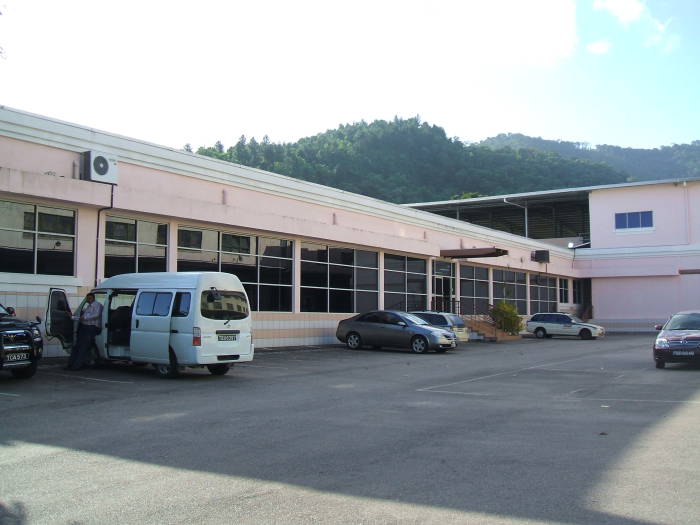

The first telephone in Trinidad appeared in 1883. Around 1890, telephone service was mainly limited to Port of Spain. A line ran out of Carenage with some customers there, and then just one customer in Chaguaramas. This early system used telephones powered by local storage batteries, tied to a central magneto switchboard.
The government extended telephone service into rural areas through the early 1900s. The central switchboard was replaced with the first 10,000-line step-by-step exchange in 1936. The step-by-step exchanges were expanded to cover suburban and urban areas from then into the 1960s.
A strike had lasted for 1,124 days, just over three years, into 1960. The government stepped in and purchased what had been the strike-idled Trinidad Consolidated Telephones Limited, and the state-owned Trinidad and Tobago Telephone Service was created. Now it is known as Telecommunications Service of Trinidad and Tobago and is jointly owned by the government and Cable and Wireless.
Electronic exchanges were first installed in 1981, most of them the ND 20 units. Nortel DMS-100 digital switches were installed throughout the country between 1983 and 1989. Mobile telephony has been the major growth area for the past several years.
Along with other regional Cable and Wireless companies, TSTT re-branded its mobile service as bmobile. Their TDMA network was shut down at the end of August, 2006, and a CDMA data service was launched in early 2007.
Digicel, a GSM competitor operating in other Caribbean nations, started operation in 2006. A Trinidadian owned company LAQTEL was awarded a CDMA license, but it has since been revoked.
TSTT has offered dial-up, ADSL, and EVDO wireless broadband. They offer leased circuits, frame relay, and metro Ethernet running up to 1 Gbps. In 2007 they introduced an ADSL2+ broadband service with speeds up to 10 Mbps.
This is the view from the work site.
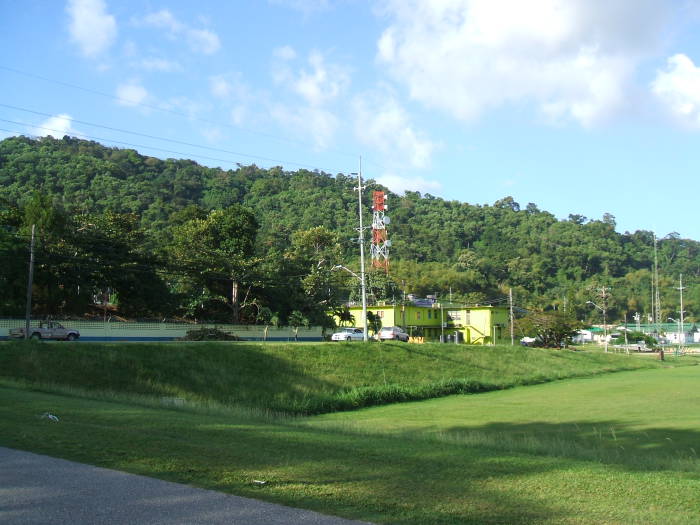
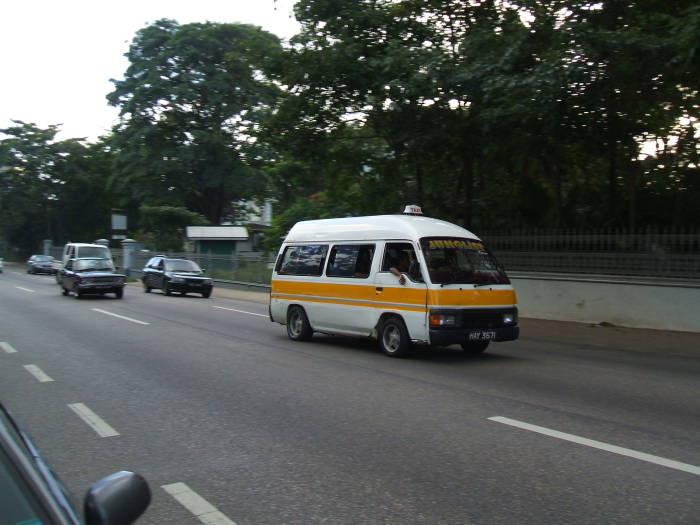
Heading Home in the Afternoon
This is one of the maxi-taxis I took back from work in the afternoons, and to get everywhere else. They're shared vans running fixed routes, about like Turkish dolmuşlar. The routes are indicated by the colored stripe around the van.
The class started rather early, getting us out about 3:30 PM. That gave me some time to explore Port of Spain every evening.
The maxi-taxis run on fixed routes but on no fixed schedule. They start when they get full enough.
You pay depending on how far you're going.
Flag one down and jump in!
Tell the driver where you're going and they will quote the price (always very low!).
You pay as you get out. If you're sitting toward the back, pass your money forward and your change will return the same way. You need to have a fistful of small bills, ideally TT$ 1 notes.
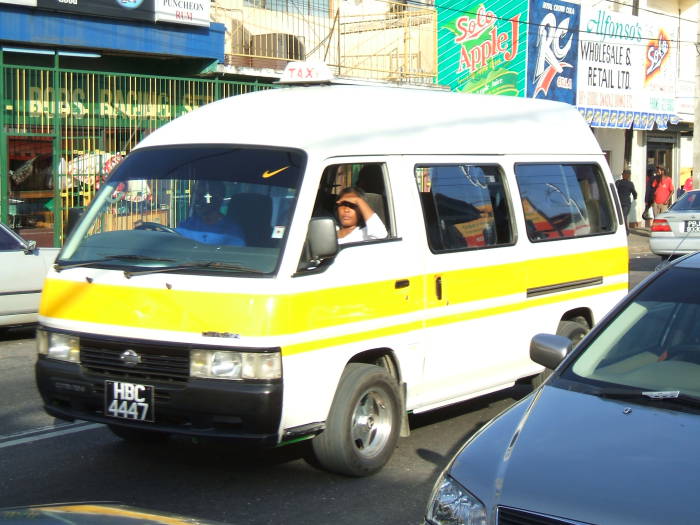
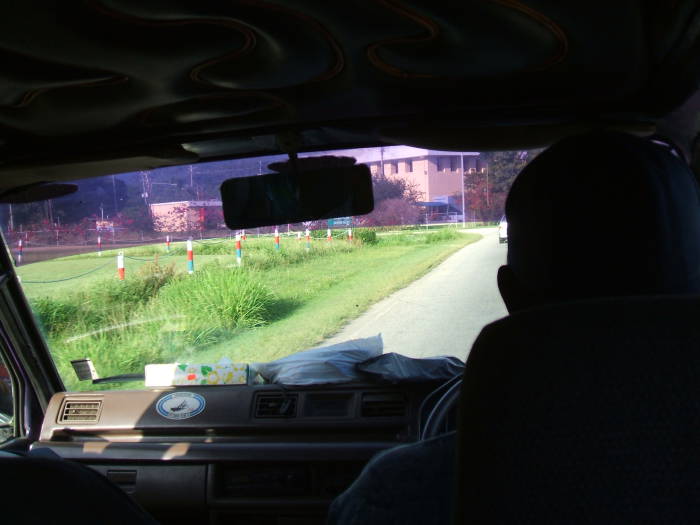
We're inside the maxi-taxi, sitting near the front with a decent view out the front.
I'm on my way back from the last day of work. It's Friday, high time for a casual lime with most of the TSTT staff from the class.
This is Pearl's Guesthouse, a great place to stay. Once the job was over I left the hotel and moved into Pearl's. More on this on the next page.
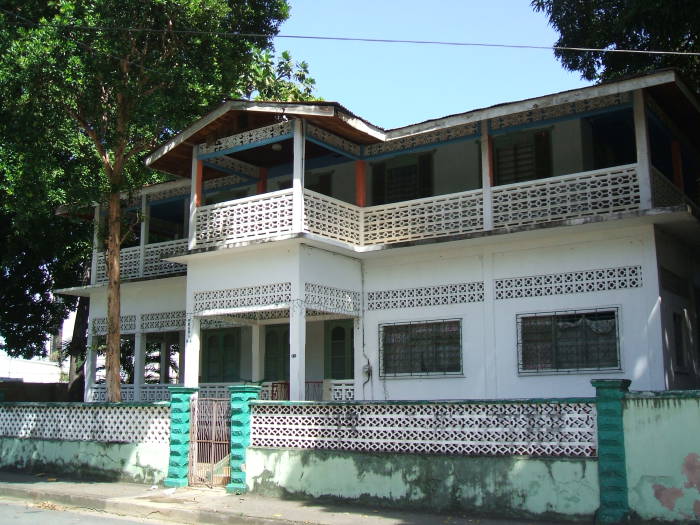
A single room at Pearl's cost just US$ 15 a night outside Carnival seaon. It's at 3-4 Victoria Square East, the phone is +1-868-625-2158.
To make a reservation, just call them up. But call at some time during the day in Trinidad, please — it's just Pearl and her husband running the place! I don't think they take credit cards, but there are ATMs all over Port-of-Spain.
And, of course, also see the Toilets of the World page if you're curious about its plumbing.